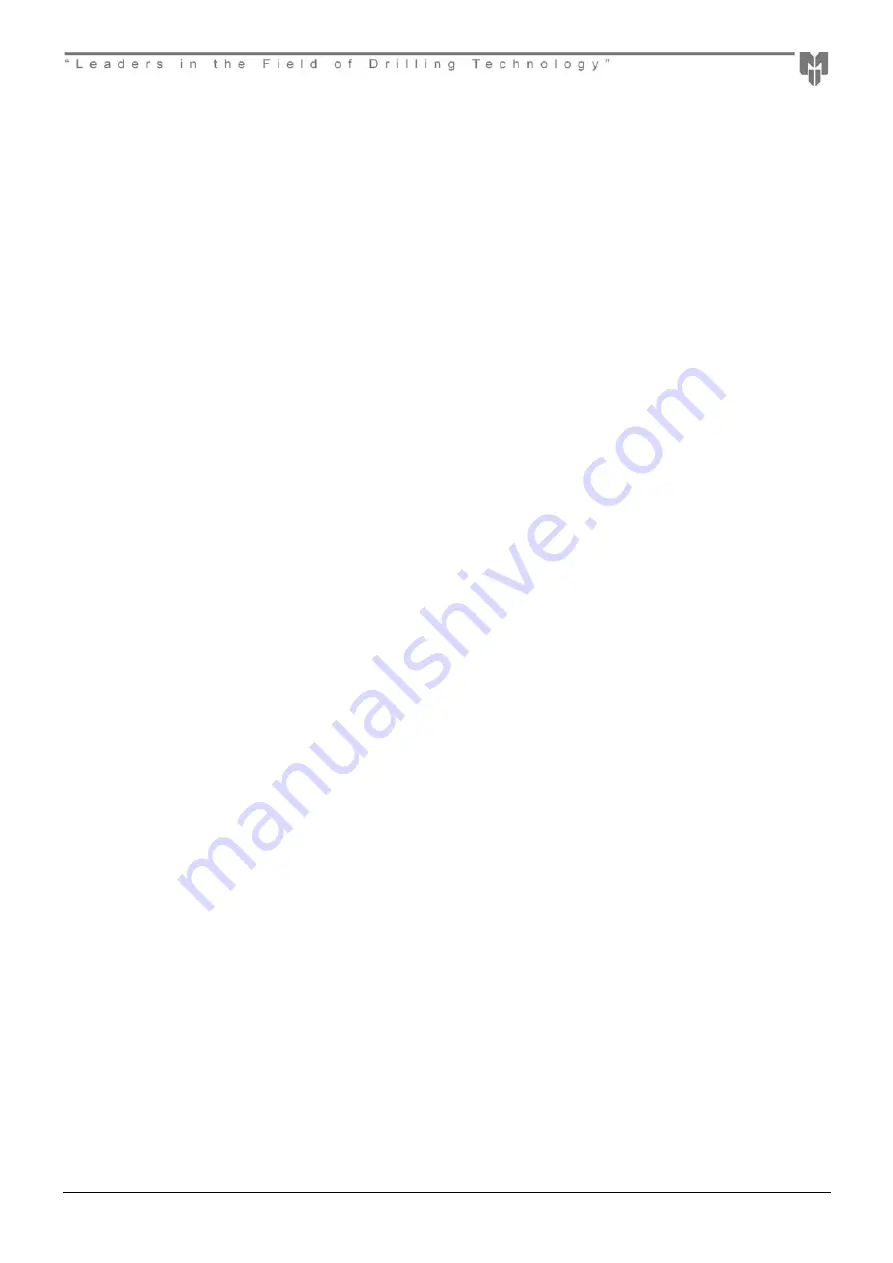
Mincon Rockdrills – “The Driller’s Choice”
Page 5
keep a spare set of jaws with the rig. Do not strike or hit the outer components as this could weaken the heat treated steels.
Hitting the hammer may also cause hard metal fragments to be chipped off which may be projected and cause personal injury
or eyesight loss.
Do not apply heat to the hammer, as this can alter the metallurgical composition and result in premature failure. Additionally,
applying heat can also cause distortion to the wear sleeve, which in turn would lead to failure. Do not trap the hammer under
drill rig tracks or vehicle wheels which could cause bending and distortion of the hammer body. Failures caused by these
actions cannot be supported by warranty.
Take care when dismantling the hammer to make sure that parts and drill bits do not become detached and cause damage or
personal injury.
2.3.3
Dismantling Hammer to Change Drill Bit
When possible, dismantling the Hammer to change the drill bit is preferably best done in a workshop environment to avoid the
risk of injury and for cleanliness. Be careful to ensure that the drill bit and chuck are fully supported together so that there is no
risk of them becoming detached and causing injury. This can occur if the O Ring on the bit retaining rings is missing or
damaged. Before fitting a new drill bit visually inspect the splines of the chuck and the piston striking face to ensure that both
are not damaged in any way.
Place chuck onto the bit, and secure with the bit retaining rings above the chuck. The 6DH bit retaining rings are reversible.
Liberally grease the threads on the chuck. Screw chuck into wear sleeve by hand, alternatively, if using the rig to screw chuck
on, ensure that no cross threading occurs. Prior to use, place bit in a bit basket and torque up chuck. This is essential, as the
chuck can loosen if not properly torqued, and premature chuck failure can occur.
2.3.4
Disassembly for Full Servicing of Hammer
Breakout the Chuck and Backhead as described previously. Unscrew chuck and remove bit and bit retaining rings. Unscrew
the backhead and check to see if the check valve and spring are operating correctly, and then remove them. Mark one end to
identify either the chuck or backhead end for reassembly latter.
Stand hammer up with the chuck end uppermost. Using a mild steel bar, tap the strike face of the piston to remove the air
distributor and inner cylinder. The steel make-up ring and lock ring and spacer should fall out during this process, if so remove
them and continue until the top of the air distributor is at the top of the wear sleeve. The hammer can now be placed flat on the
ground or put up onto a suitable vice, and using the mild steel bar, hit the piston strike face from the chuck end, to completely
remove the air distributor, inner cylinder and piston.
Stand the wear sleeve up with the chuck end on the ground. Invert the piston and drop into the wear sleeve so that it is upside
down. Take care to ensure that fingers do not get caught between the piston and wear sleeve. Again stand the hammer up
with the backhead end uppermost, and tap the piston strike face with the mild steel bar to remove the aligner. A number of
blows may be necessary as the aligner and wear sleeve are an interference fit.
The piston retaining ring can be removed by using a mild steel bar and hitting the section opposite the gap on the ring which will
ride up the taper on the wear sleeve and come out. It can then be pulled out by hand.
2.3.5
Inspection
Prior to inspection, thoroughly clean all parts using a suitable cleaning agent. Diesel is not recommended for cleaning as it can
cause erosion to components, and damage to health.
All parts should be visually inspected for any signs of damage, wear or cracking. The inner cylinder, wear sleeve and lock rings
can be checked for unseen cracking by suspending them and lightly tapping with a screw driver. If they emit a ringing tone then
they should be sound. However, a dull flat tone if emitted may indicate cracking, and the part should be replaced.
Take particular care to check the internal bore of the wearsleeve for pick-up marks and galling. If these are present, the barrel
of the wear sleeve should be honed out, using a hand hone to remove them.
Inspect surface of the piston for pick-up marks and galling (usually caused through poor lubrication or the presence of
contaminants) and smooth out with emery paper or a hand held grit stone. Where galling of the piston has occurred, substantial
heat has been generated and quite often, micro cracking has occurred on the piston. In these cases, the piston should be
replaced if there is evidence of such cracking. Check the strike face of the piston for cracking or damage.
2.3.6
Checking Wear Limits
The performance of the hammer is dependent on the amount of wear the critical components have. These should be measured
and recorded in the Service log in the appendix. The service log gives the location of where measurements should be made.
Depending on how many parts need to be replaced, it may be economical to replace the hammer all together.
Where the reverse wear limit has been reached on the outer diameter at the chuck end of the wear sleeve, the hammer can be
reassembled with the backhead end becoming the chuck end. Additionally if the internal running surface in the wear sleeve for
the piston is excessive, the wear sleeve can be reversed.
Summary of Contents for 6DH360
Page 1: ...Mincon 6DH360...




























